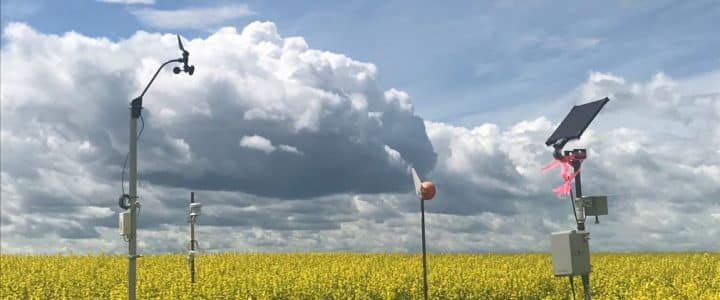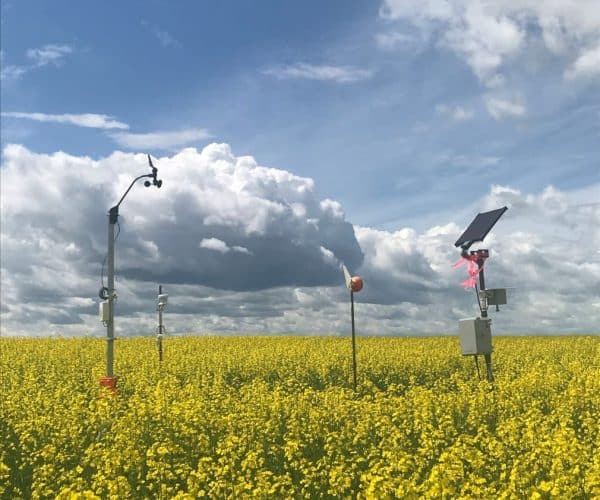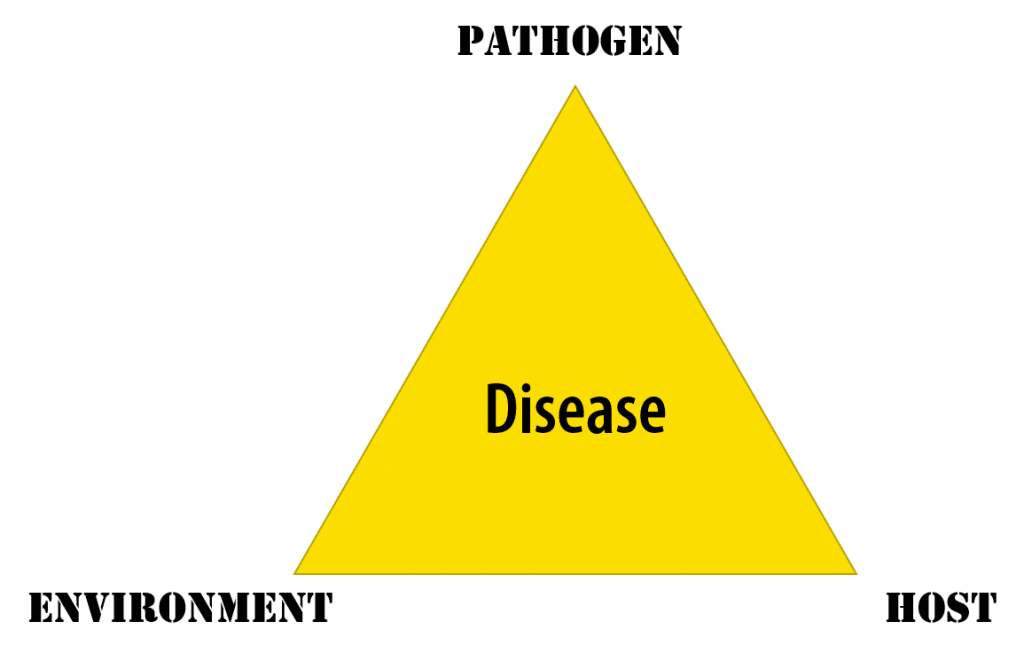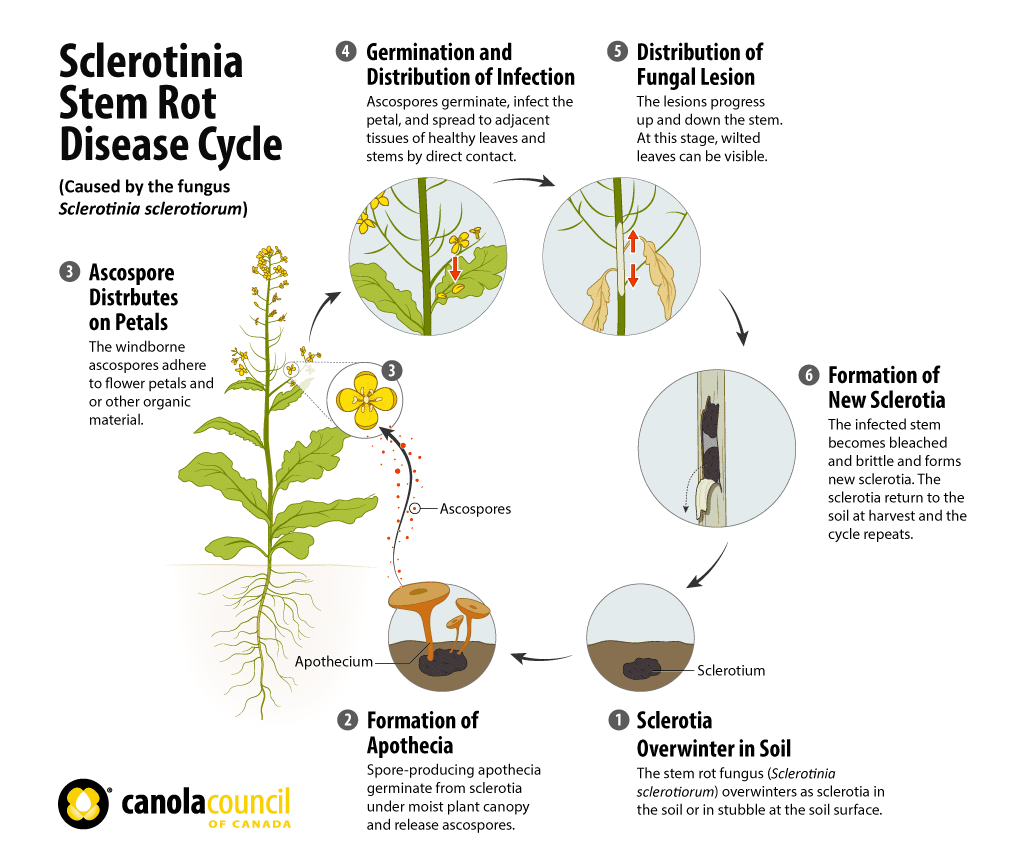Photo credit: Eleanor McBain
Sclerotinia stem rot is a major disease of canola that continues to be a challenge to manage- largely due to its difficulty to predict. This blog explores some of the tools that are currently available to support the decision-making around sclerotinia and prediction and control options that are still being investigated.
Foundational disease information
Similar to other diseases, all three aspects of the disease triangle must align for sclerotinia to occur in canola. The host plant (canola) must be present. The disease-causing pathogen, which in this case is the fungus Sclerotinia sclerotiorum, must be present and the environment must provide favourable conditions. The challenge with sclerotinia, is that the presence of viable pathogen (often referred to as inoculum) and the quantity that is needed to successfully infect an economic amount of canola plants to warrant a fungicide application is difficult to collect precise measurements on. As well, all the specific conditions required to create a favourable environment for the disease aren’t fully known and are hard to predict.
However, every unique growing season for canola farmers and every research study completed provides a greater understanding and more insight into answering these questions and better management of this disease.
Apply this on your farm
- Try the Sclerotinia Risk Assessment tool.
- Check out the other sclerotinia resources.
- Use integrated sclerotinia forecasting including monitoring inoculum and weather conditions.
- Watch the Sclerotinia spray decision video.
- Review the sclerotinia disease cycle and refer to it while considering monitoring options.
Sclerotinia disease cycle
Similar to other diseases, all three aspects of the disease triangle must align for sclerotinia to occur in canola. The host plant (canola) must be present. The disease-causing pathogen, such as the fungus Sclerotinia sclerotiorum, must be present and the environment must provide favourable conditions.
The challenge with sclerotinia, is that it is difficult to collect precise measurements on the presence of viable pathogen (often referred to as inoculum) and to determine the quantity needed to successfully infect an economic amount of canola plants (to warrant a fungicide application). As well, all the specific conditions required to create a favourable environment for the disease aren’t clearly defined and are hard to predict.
But every farm’s unique growing season and every research study completed provides more insight into answering these questions and better management of this disease.
A quick refresh of the sclerotinia disease cycle adds context to monitoring specifics. As pictured, after the pathogen overwinters as sclerotia in the soil or in the stubble at the soil surface, it grows fungal fruiting bodies called apothecia. Under certain moist plant canopy conditions, the apothecia germinate and release ascospores (a type of spore). These ascospores travel by wind and can land on and adhere to organic material, such as canola flower petals, especially as the petals drop onto the leaves close to the stem. When the ascospores germinate (under the correct conditions) they infect the petal, and can spread to leaves and stems by direct contact. This will lead to lesions forming on the plant which can progress up and down the stem and result in wilted leaves.
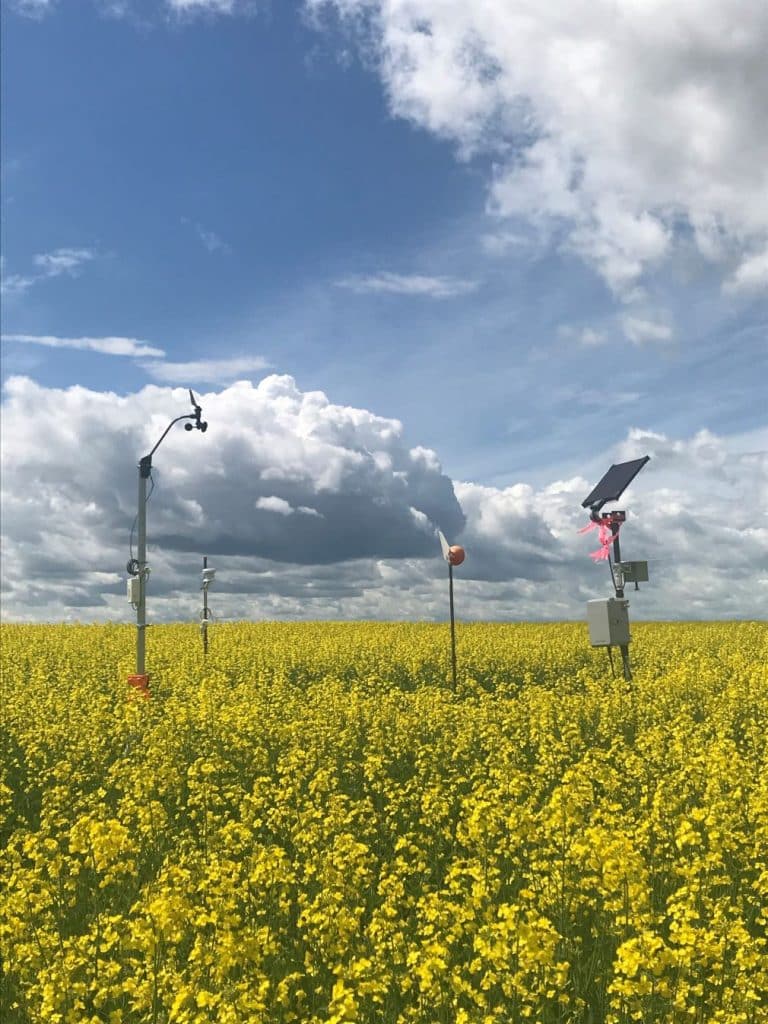
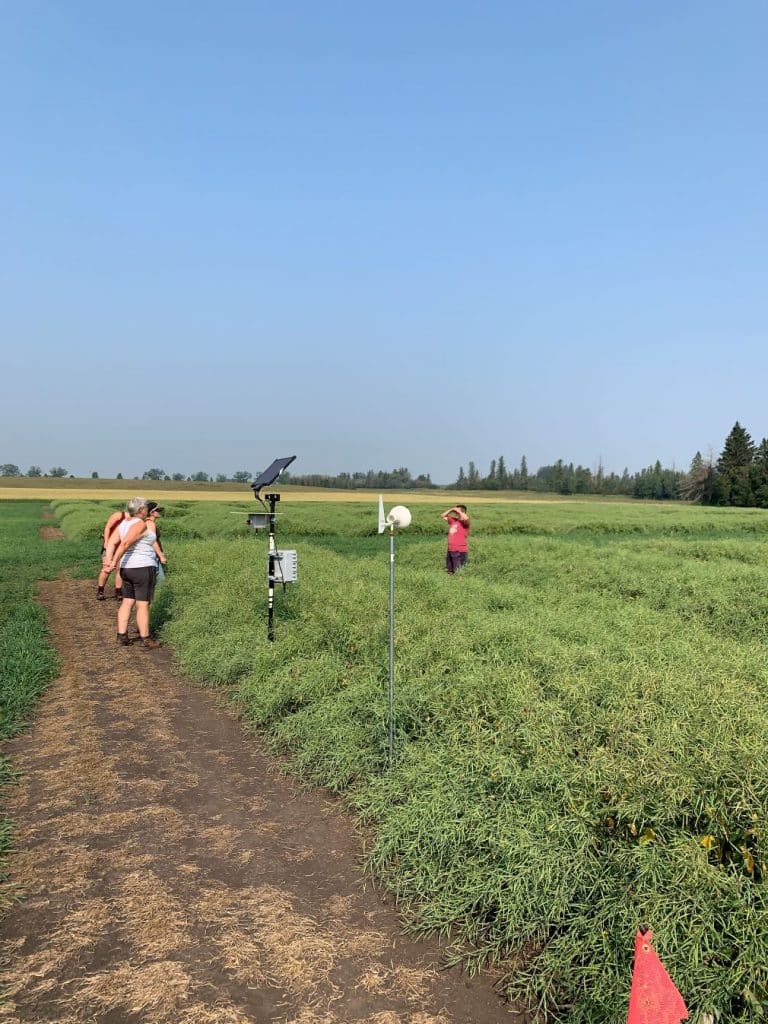
Refining sclerotinia forecasting
Turkington’s Improving the management of sclerotinia stem rot of canola using fungicides and better risk assessment tools study investigated how environmental conditions (including relative humidity, temperature, and rainfall) influence the amount and risk of S. sclerotiorum inoculum over the canola flowering period, and how these factors affect final sclerotinia disease incidence and severity. It also tested spore traps and DNA-based petal testing as methods to forecast disease risk.
Since conditions were generally not conducive to disease development at several of the trial sites in 2019, 2021 and 2022, the research was able to confirm that when the risk of stem rot is low based on weather and inoculum conditions, fungicide application is not needed and provides no crop productivity or economic benefit in terms of yield.
Integrated sclerotinia forecasting approach
The research also reported that an integrated sclerotinia forecasting approach is the best way to generate accurate sclerotinia predictions, since many variables affect sclerotinia development. Ideally, this approach would include monitoring inoculum levels prior to and during the flowering period and in-field ambient air and canopy relative humidity levels.
More specifically:
- Inoculum monitoring method. Canola petal tissue tests (coupled with weather variables) were the best inoculum monitoring method, with the strongest relationship to disease incidence (R2 = 86%) and severity (R2 = 87%) during early-mid flowering, compared to the Spornado (which accounted for 48% and 40% of the variation in disease incidence and severity, respectively, and the rotorod accounting for 52% and 50% of variation in disease incidence and severity, respectively.
- Fortunately, only one sampler per field may be sufficient for monitoring, according to this research; however, more testing is required for large fields. As well, the sampler should be located in the center of a field if possible, or at least downwind of the prevailing wind.
- Ambient (air) relative humidity. Relative humidity conditions of >80% for more than 21 hours per day were reported to be conducive for the disease.
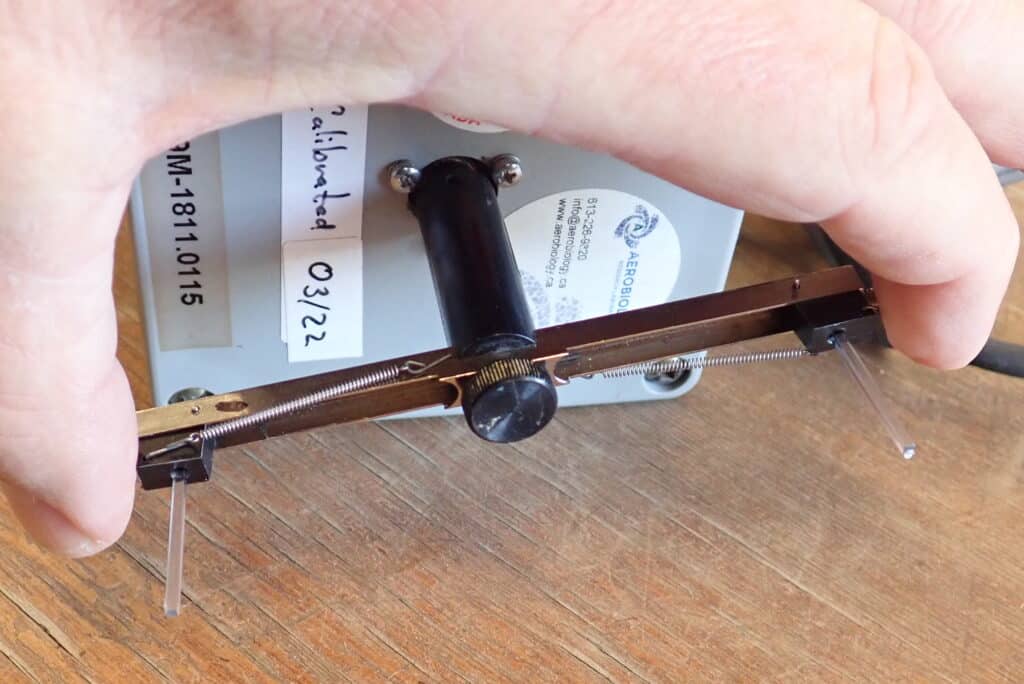
- Canopy relative humidity. In-canopy relative humidity was found to be significantly different (between 3 to 13% greater) than the ambient (air) relative humidity. So if in-canopy monitoring isn’t possible, canopy relative humidity could be estimated at ~6% above ambient relative humidity.
- Other factors:
- Seeding rates. In this study a higher seeding rate of ~120 seeds/m2 likely increased inter-plant competition (compared to a seeding rate of ~60 seeds/m2) which may have lead to faster plant development. The higher seeding rates increased yields at five of the 10 sites (which could be related to the improved weed competitiveness) and increased thousand seed weight at four of the sites, but had inconsistent impacts on oil and protein content at different sites.
- Soil moisture. Sclerotinia prediction models could indicate that additional factors need to be included, such as soil moisture and the population of sclerotia in the soil.
- Maturity. This study concluded that the potential “stay green” effect of fungicide does not benefit canola, as maturities were also not impacted by fungicide application.
Conclusion
Overall, this research concluded that a relative humidity of >80% (especially for >21hr/day) and a spore minimum of 0.0001 nanograms of S. sclerotiorum DNA per canola petal or per cubic meter of air per hour (or commercial petal tests showing >30-45% petal infestation) during early flowering would likely result in disease incidence of >15%, at which fungicide application is generally recommended.
Additional sclerotinia research involving monitoring devices
Check out the Development of a biosensor for sclerotinia stem rot disease forecasting in canola research on developing an in-field real-time sensor to monitor plant disease pathogens, specifically the sclerotinia stem rot pathogen.
Factors impacting sclerotinia risk
The factors highlighted in Improving the management of sclerotinia stem rot of canola using fungicides and better risk assessment tools study are aligned with the parameters provided in three other sclerotinia risk assessment tools available on the Prairies:
- The Canola Council of Canada has a new sclerotinia management tool, which lists: rainfall in the last 2 weeks, chance of rain in the next 3 days, plant density, years since last host crop, sclerotinia severity in the last host crop and estimation of sclerotia germination as sclerotinia risk assessment at flowering.
- The new tool offers a recommendation about whether or not to spray a canola crop (at 20-50 per cent flower) and an opportunity to assess the spray decision by rating disease severity at maturity (30-60 per cent seed colour change.) It also features an economic calculator and a helpful sclerotinia resource library.
- Manitoba Agriculture’s Canola Sclerotinia Treatment Decision Calculator, (similarly) lists: the number of years since the last canola crop, disease incidence in the last host crop, current crop density, rain in the last two weeks, weather forecast and regional risk for apothecia development as the six risk factors for the development of sclerotinia disease in canola.
- Alberta offers the Sclerotinia Infection Risk tool which provides hourly sclerotinia infection risk over the past 10 days. Using air temperature and relative humidity at a given location this tool calculates whether the infection risk is a minor risk, low infection, near miss or infection alert.
- The The Prairie Crop Disease Monitoring Network (PCDMN) offers a Sclerotinia of canola assessment protocol, a sclerotinia disease scouting quick reference card and in-season updates.
Sclerotinia management resources
Additional tools to support farmers and agronomists in the understanding of sclerotinia and disease management include this Factors in the sclerotinia spray decision article and the following videos and podcast:
Published July 31, 2024


